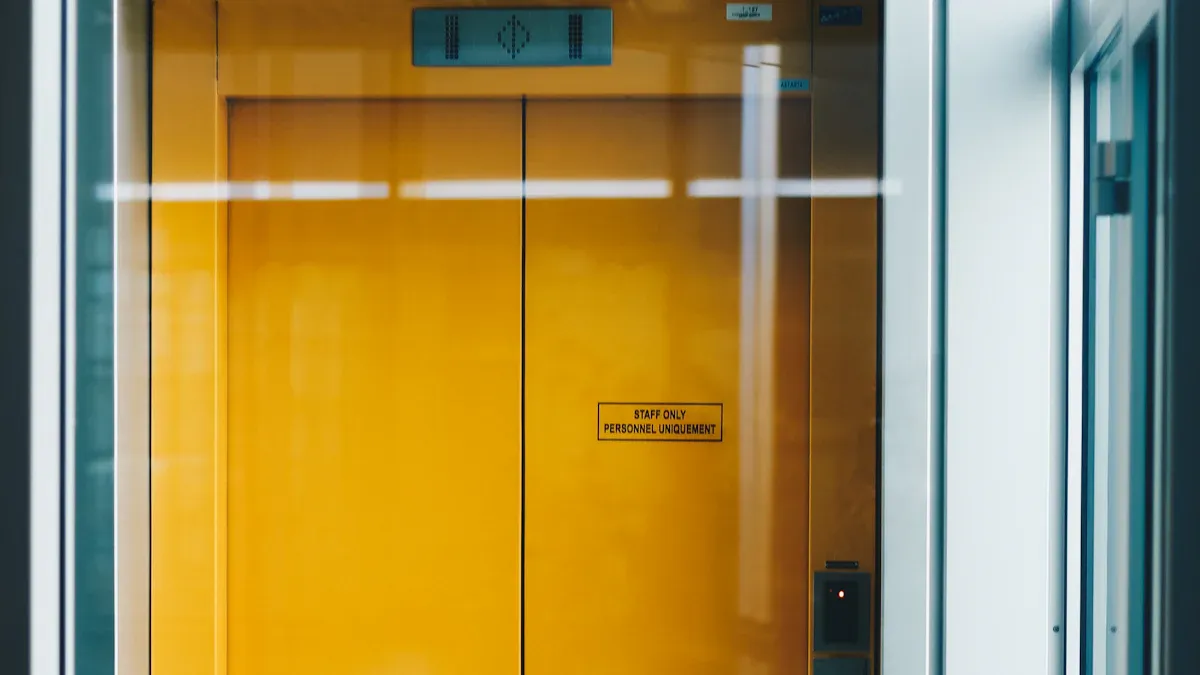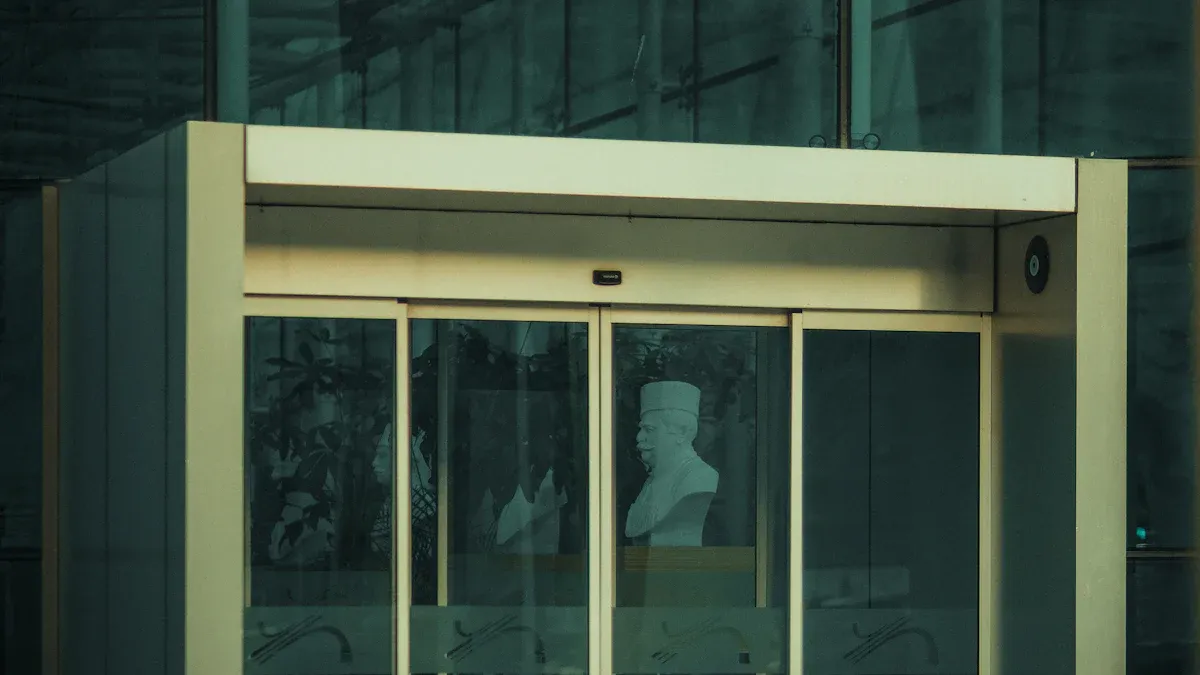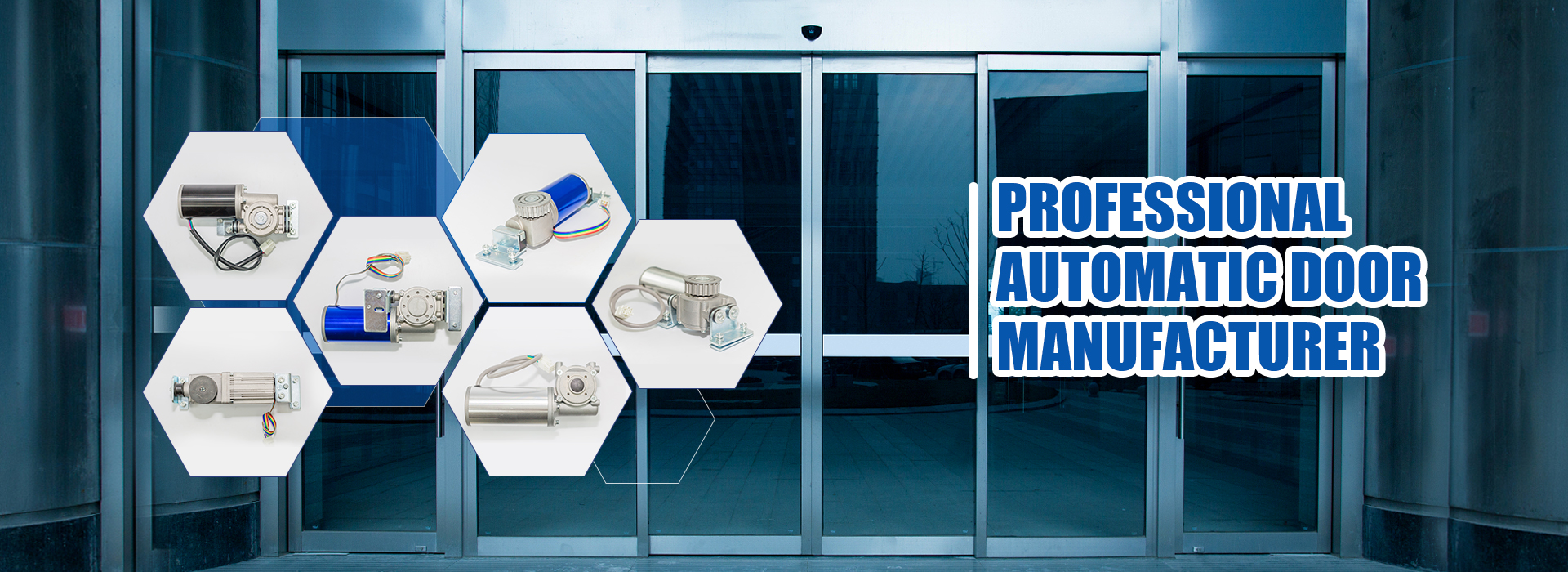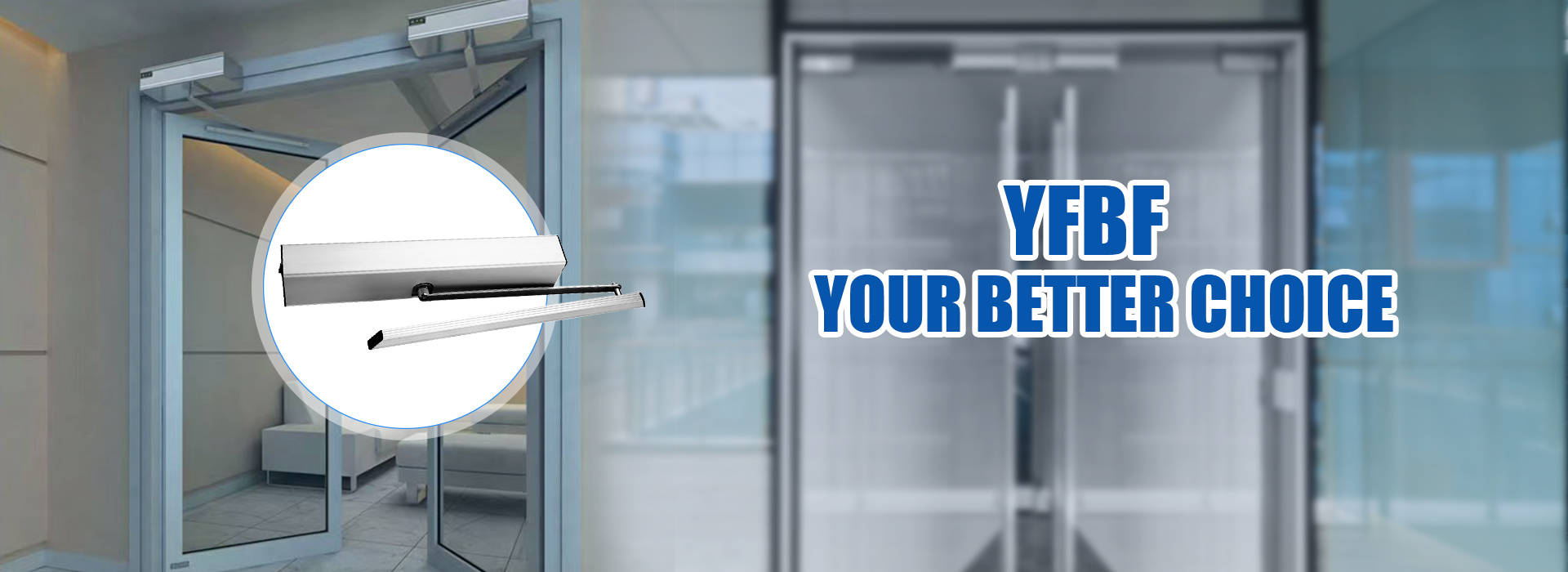
Safe installation of an automatic sliding door opener commercial system requires strict adherence to manufacturer guidelines and certified professionals. Over 40% of commercial buildings opt for automatic sliding door openers for reliable and efficient entryways.
| Aspect | Percentage / Share |
|---|---|
| Commercial segment market share | Over 40% |
| Automatic doors market share | Approximately 80% (2026 est.) |
| Retail stores share | Around 35% |
| Hospitals share | Around 25% |
Common safety incidents include sensor malfunctions, unexpected door movements, and injuries from disabled safety features. Regular daily inspections and professional servicing ensure safety for all users.
Key Takeaways
- Choose certified professionals for installation to ensure safety, proper alignment, and to keep warranties valid.
- Use advanced sensors and emergency features to prevent accidents and allow quick exits during emergencies.
- Schedule regular maintenance and safety checks to keep doors reliable, extend their lifespan, and protect all users.
Essential Features of Automatic Sliding Door Opener Commercial

Sensor Technology for Safety
Modern automatic sliding door opener commercial systems rely on advanced sensor technology to keep everyone safe. These doors use radar, laser, and vision-based sensors to detect people, objects, and even animals. The sensors can tell the difference between a person and a cart, which helps prevent accidents. When someone approaches, the sensors trigger the door to open smoothly. If something blocks the path, the sensors stop or reverse the door, reducing the risk of injury.
Tip: Advanced sensors lower accident rates by reducing false triggers and missed detections. This means fewer unexpected door movements and safer entryways for everyone.
Many commercial spaces, such as hospitals and shopping malls, choose these systems because they offer reliable protection. The sensors also help the doors operate efficiently, opening only when needed and closing quickly to save energy.
Emergency Release Mechanisms
Safety in emergencies is a top priority for any automatic sliding door opener commercial installation. Emergency release mechanisms allow people to exit quickly during power failures or fire alarms. These systems often include manual release handles, battery backups, and emergency stop buttons. When the power goes out, the battery backup keeps the door working. If there is a fire, the manual release lets people open the door by hand.
- Manual release handles for quick exit
- Battery backup for power outages
- Emergency stop buttons for immediate halting
These features meet strict safety codes and help everyone evacuate safely. Regular inspections ensure that emergency releases work when needed. Staff should know how to use these features in case of an emergency.
Obstruction Detection Systems
Obstruction detection systems protect people and property from harm. These systems use photoelectric beams, microwave, infrared, and ultrasonic sensors to spot anything in the door’s path. If the system detects an obstruction, it stops or reverses the door right away. This prevents the door from closing on someone or damaging equipment.
- Photoelectric sensors stop and reverse the door if something is in the way
- Anti-entrapment features protect against pinched fingers or trapped objects
- Warning devices alert users to potential hazards
Professional installers add these safety accessories to meet industry standards. Obstruction detection is especially important in busy places like airports and office buildings, where many people pass through each day.
Safety Signage and Accessibility
Clear safety signage and easy accessibility make automatic sliding door opener commercial systems user-friendly. Signs show people how to use the doors and warn them about moving parts. Good signage helps prevent confusion and accidents. Accessibility features, such as wide openings and smooth thresholds, allow everyone to enter and exit easily, including those with disabilities.
| Safety Feature | Benefit |
|---|---|
| Clear signage | Prevents misuse and confusion |
| Wide door openings | Improves wheelchair access |
| Smooth thresholds | Reduces tripping hazards |
| Operating instructions | Guides safe use |
Note: Proper signage and accessible design help businesses meet legal requirements and create a welcoming environment for all visitors.
Automatic sliding door opener commercial systems combine these essential features to deliver silent, stable, and efficient operation in hotels, airports, hospitals, shopping malls, and office buildings. By choosing a system with advanced safety features, businesses protect their staff and customers while ensuring smooth daily operations.
Pre-Installation Safety Checklist for Automatic Sliding Door Opener Commercial
Site Assessment and Measurements
A safe installation starts with a careful site assessment. The team checks the doorway for enough space above and beside the opening. They measure the width and height to make sure the automatic sliding door opener commercial system fits perfectly. Clear pathways help people move safely. Installers look for any obstacles, such as furniture or uneven floors, that could block the door’s movement. They also check the wall structure to ensure it can support the weight of the door and operator.
Tip: Accurate measurements prevent costly mistakes and delays during installation.
Power Supply and Wiring Safety
A reliable power supply keeps the door running smoothly. Installers inspect the electrical system before starting work. They use dedicated circuits to avoid overloading. All wiring must stay away from water sources and sharp edges. Proper grounding protects against electrical shocks. Installers secure cables neatly to reduce tripping hazards. Only trained professionals should handle wiring to guarantee safety and compliance.
- Use a dedicated circuit for the door opener
- Keep wires organized and protected
- Hire certified electricians for all electrical work
Compliance with Local Codes and Standards
Every commercial project must follow strict codes and standards. These rules protect users and ensure accessibility. The most common codes include:
- International Building Code (IBC)
- International Fire Code (IFC)
- ICC A117.1 – Accessible and Usable Buildings and Facilities
- 2010 ADA Standards for Accessible Design
- NFPA 101 – The Life Safety Code
Local authorities may require extra steps. Key requirements cover minimum clear opening widths and heights, limits on hardware projections, and accessibility for all users. Installers check with the Authority Having Jurisdiction (AHJ) to confirm all rules apply to the specific location.
Meeting these standards helps businesses avoid fines and ensures everyone can use the door safely.
Safe Installation Process for Automatic Sliding Door Opener Commercial
Professional Installation vs. DIY Considerations
Choosing professional installation for an automatic sliding door opener commercial system ensures safety and reliability. Trained technicians follow strict safety protocols and industry standards. They know how to handle heavy doors and tensioned springs, which can cause serious injuries if managed incorrectly. Professionals also understand the risks of electrical components and moving parts. Many manufacturers require professional installation to keep warranties valid. Improper DIY installation can lead to malfunction, costly repairs, and even voided warranties.
- Professional installers guarantee proper alignment and correct spring tension.
- They reduce the risk of injury and prevent improper installation.
- DIY attempts often result in safety hazards and unpredictable door function.
For the safest and most reliable results, businesses should always choose certified professionals for installation.
Proper Mounting and Alignment
Proper mounting and alignment form the foundation of a safe and efficient automatic sliding door opener commercial system. Installers start by preparing all necessary tools and materials, such as drills, screwdrivers, levels, measuring tapes, and anchoring hardware. They measure and mark mounting points on the wall or frame with precision. This step ensures the header track and motor unit sit level and secure. Vibration-resistant fasteners keep the system stable during operation.
Installers attach sliding door hanger rollers to the door panel and install the bottom door guide. This guide keeps the door aligned and prevents derailment. The control system and sensors connect next, with careful attention to wiring and placement. Professionals configure system settings, including opening and closing speed, hold-open time, and sensor sensitivity. Each adjustment supports smooth, silent, and safe door movement.
Accurate alignment and secure mounting prevent unpredictable door function and safety hazards. Businesses benefit from a system that operates smoothly and stands up to daily use.
Testing Safety Features and Operation
Testing every safety feature is essential before handing over the system to users. Installers check the door’s movement for smooth operation and confirm that sensors respond quickly to people and objects. They test emergency release mechanisms and obstruction detection systems. Each safety feature must work as intended to protect users from harm.
Installers follow these steps to ensure complete safety:
- Test the door’s opening and closing for smooth, silent movement.
- Check sensor responsiveness to people, carts, and other objects.
- Activate emergency release mechanisms and verify manual operation.
- Inspect obstruction detection systems for immediate stopping or reversal.
- Review system settings for correct speed, hold-open time, and sensitivity.
- Perform a final inspection to confirm compliance with safety codes.
- Provide maintenance instructions and user guidance to staff.
Thorough testing and final inspection guarantee that the automatic sliding door opener commercial system meets all safety requirements. Staff receive clear instructions for daily use and emergency situations.
Post-Installation Safety for Automatic Sliding Door Opener Commercial
Regular Maintenance and Inspections
Facility managers schedule regular maintenance to keep automatic sliding door opener commercial systems safe and reliable. Certified professionals inspect doors at least once a year, following recommendations from the American Association of Automatic Door Manufacturers (AAADM). High-traffic areas, such as airports and shopping malls, require more frequent checks—sometimes every three to six months. Staff perform daily safety checks to spot issues early. These inspections prevent costly repairs and help maintain compliance with safety standards.
| Door Type | Maintenance Frequency |
|---|---|
| Single sliding doors | Every 6–12 months |
| Dual sliding doors | Every 3–6 months (high traffic) |
| Folding doors | Every 6 months |
| Revolving doors | Quarterly |
| Swinging doors | Every 6–12 months |
| Surface-mounted doors | Every 6 months |
Regular inspections protect users and extend the life of the door system.
Staff Training and User Awareness
Staff receive ongoing training to operate and monitor automatic sliding door opener commercial systems. Training covers how to recognize sensor malfunctions, improper door speeds, and activation device problems. Employees learn to report issues quickly, helping avoid accessibility barriers. AAADM-certified inspectors provide annual audits, ensuring staff stay updated on safety protocols and ADA guidelines. Businesses benefit from trained teams who keep entryways safe and accessible for everyone.
Periodic Safety Checks
Periodic safety checks follow industry standards and keep doors functioning properly. Qualified contractors test and calibrate sensors every three to six months. Mechanical and electrical components undergo regular inspection. Staff clean and lubricate moving parts to prevent breakdowns. Facilities comply with ADA regulations and local building codes, ensuring legal conformity. Safety checks by certified professionals guarantee that every automatic sliding door opener commercial system meets strict standards.
- Test sensors for quick response
- Inspect mechanical and electrical parts
- Clean and lubricate moving components
- Confirm ADA and code compliance
- Use certified contractors for all safety checks
Consistent safety checks create a secure environment and build trust with visitors.
Common Mistakes to Avoid with Automatic Sliding Door Opener Commercial
Skipping Safety Checks
Many facility managers overlook regular safety checks. This mistake allows defects and wear to remain hidden. Doors may develop operational faults and experience more downtime. Skipping inspections means sensor failures, misaligned tracks, and worn weatherstripping go unnoticed. Defective doors can create safety hazards and increase liability risks, especially in busy areas or emergency escape routes. Operators must schedule preventive maintenance to identify problems early and avoid costly repairs.
Regular inspections by certified professionals extend the lifespan of the door system and reduce the risk of accidents.
- Defects and wear remain undetected.
- Operational faults increase downtime.
- Safety hazards and liability risks rise.
Ignoring Manufacturer Instructions
Some installers ignore manufacturer instructions during setup and maintenance. This mistake leads to malfunctioning doors that threaten the safety of customers, visitors, and staff. Faulty doors may discourage people from entering the building, hurting business operations. Failure to follow instructions and safety standards can result in legal consequences if accidents occur. European and British regulations require compliance with manufacturer guidelines and standards. Building owners must ensure regular servicing by qualified professionals.
Following manufacturer instructions keeps doors safe, reliable, and compliant with regulations.
- Malfunctioning doors pose health and safety hazards.
- Business operations suffer from faulty entryways.
- Legal consequences arise from non-compliance.
Inadequate Testing and Adjustment
Installers sometimes fail to test and adjust door systems properly. Inadequate testing increases the risk of doors opening during collisions, which can cause injuries. Federal safety standards require rigorous load and inertial tests for sliding door latch systems. Without proper testing, doors may fail under crash-like forces. Children and other occupants face greater danger if doors do not meet these requirements. Regular adjustment and testing ensure doors remain secure and safe for everyone.
Proper testing and adjustment protect users and prevent accidents in high-traffic environments.
- Doors may open during collisions, risking injury.
- Failure to meet safety standards increases danger.
- Occupant safety depends on thorough testing.
Safety starts with selecting the right system and continues through expert installation and regular maintenance.
- Follow standards like ANSI/BHMA A156.10 and ADA guidelines.
- Use clear signage and daily safety checks.
- Consult certified professionals for installation and inspections.
These steps ensure reliable, accessible, and secure entryways for every building.
Post time: Aug-19-2025



